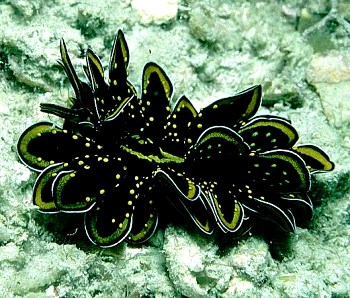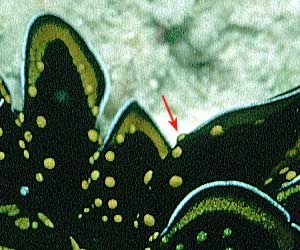Cyerce nigricans from East Africa
February 2, 2001
From: Bernard Picton


Hi Bill,
Just to confirm the wide distribution of Cyerce nigricans here is a picture
of one from Pemba Island, Tanzania (Feb 1999). Strangely enough I've never seen this conspicuous species in Indonesia or the Philippines. I noticed that it flaps its 'cerata' when disturbed and that the orange spots on the inside surfaces are raised bumps arranged in a single row around each ceras. [see second picture] Are these glands secreting the noxious substance which
make it distasteful to fish? Clay Carlson's picture of a juvenile Cyerce nigra also shows these structures. In Cyerce nigricans they seem to be mimicked by similar coloured spots on the outer (ventral) surface of the cerata.
Bernard
bernard.picton.um@nics.gov.uk
Picton, B. , 2001 (Feb 2) Cyerce nigricans from East Africa. [Message in] Sea Slug Forum. Australian Museum, Sydney. Available from http://www.seaslugforum.net/find/3684Dear Bernard,
Thanks for the East African record. There are a number of publications on the chemical secretions of Cyerce nigricans and Cyerce cristallina. I sectioned the cerata of C. nigricans many years ago and those bumps are clearly glandular but I don't know if anyone has published anything definitely locating the actual site of the icthyotoxic mucus secretions.
Two references on Cyerce nigricans are:
• Hay, M. E., Pawlik, J.R., Duffy, J.E. & Fenical,W (1989) Secondary metabolites of the chemically rich ascoglossan Cyerce nigricans. Experientia, 46: 327-329
• Roussis, V., Pawlik, J.R., Hay, M.E. & Fenical,W (1990) Seaweed-herbivore-predator interactions: host-plant specialization reduces predation in small herbivores. Oecologia, 81: 418-427.
There has also been some interesting work on the related Mediterranean Cyerce cristallina which produces a number of compounds (polyproprionate pyrones) which have been called cyercenes. Small epithelial glands in the cerata produce these cyercenes which are secreted as an icthyotoxic mucus [distasteful to fish] to protect Cyerce from fish attack. As part of the defensive strategy the cerata easily break off [autotomise] (deliberately break off) and wriggle around, secreting nasty compounds, apparently to distract the potential predator. Another metabolite 'Cyercene-A' is apparently involved in inducing the regrowth of cerata, and cerata are reported to regenerate in the incredibly short time of 8-10 days.
Three references this work on C. cristallina are:
• Vardaro, RR., Di Marzo, V., Crispino,A., & Cimino, G (1991) Cyercenes, novel polypropionate pyrones from the autotomizing Mediterranean mollusc Cyerce cristallina. Tetrahedron, 47(29): 5569-5576.
• Di Marzo, V., Vardaro, RR., De Petrocellis, L., Villani, G., Minei, R., Cimino, G. (1991) Cyercenes, novel pyrones from the ascoglossan mollusc Cyerce cristallina: tissue distribution, biosynthesis and possible involvement in defense and regenerative processes. Experientia, 47: 1221-1227.
• Di Marzo, V., Marin, A., Vardaro, R,R., De Petrocellis, L., Villani, G., Cimino, G. (1993) Histological and biochemical bases of defense mechanisms in four species of Polybranchioidea ascoglossan molluscs. Marine Biology, 117: 367-380.
Best wishes,
Bill Rudman
Related messages
-
Cyerce nigricans from sthn Queensland, Australia
From: Bruce Wilkie, April 11, 2008 -
Cyerce nigricans from the Solomon Ids
From: Bruce Potter, April 21, 2005 -
Cyerce nigricans from Tahiti
From: Taiana Darius , February 22, 2002 -
Tropical sea slug from Huahine
From: Taiana Darius, February 16, 2002 -
Cyerce nigra? from Mozambique
From: Ian Miller, July 8, 2001 -
Cyerce nigricans from French Polynesia
From: Daniel L. Geiger, December 15, 2000 -
Cyerce nigricans from Heron Island
From: John Walker, December 12, 2000 -
Cyerce nigricans from Heron Island
From: Julie Marshall, July 14, 1999
